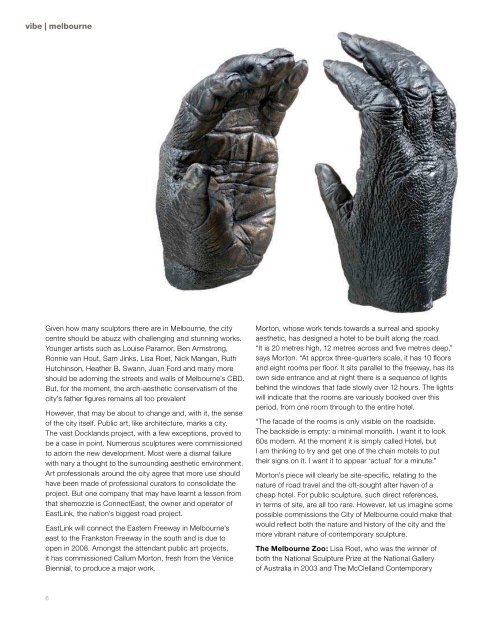You also want an ePaper? Increase the reach of your titles
YUMPU automatically turns print PDFs into web optimized ePapers that Google loves.
vibe | melbourne<br />
Given how many sculptors there are in <strong>Melbourne</strong>, the city<br />
centre should be abuzz with challenging and stunning works.<br />
Younger artists such as Louise Paramor, Ben Armstrong,<br />
Ronnie van Hout, Sam Jinks, Lisa Roet, Nick Mangan, Ruth<br />
Hutchinson, Heather B. Swann, Juan Ford and many more<br />
should be adorning the streets and walls of <strong>Melbourne</strong>’s CBD.<br />
But, for the moment, the arch-aesthetic conservatism of the<br />
city’s father figures remains all too prevalent<br />
However, that may be about to change and, with it, the sense<br />
of the city itself. Public art, like architecture, marks a city.<br />
The vast Docklands project, with a few exceptions, proved to<br />
be a case in point. Numerous sculptures were commissioned<br />
to adorn the new development. Most were a dismal failure<br />
with nary a thought to the surrounding aesthetic environment.<br />
Art professionals around the city agree that more use should<br />
have been made of professional curators to consolidate the<br />
project. But one company that may have learnt a lesson from<br />
that shemozzle is ConnectEast, the owner and operator of<br />
EastLink, the nation’s biggest road project.<br />
EastLink will connect the Eastern Freeway in <strong>Melbourne</strong>’s<br />
east to the Frankston Freeway in the south and is due to<br />
open in 2008. Amongst the attendant public art projects,<br />
it has commissioned Callum Morton, fresh from the Venice<br />
Biennial, to produce a major work.<br />
6<br />
Morton, whose work tends towards a surreal and spooky<br />
aesthetic, has designed a hotel to be built along the road.<br />
“It is 20 metres high, 12 metres across and five metres deep,”<br />
says Morton. “At approx three-quarters scale, it has 10 floors<br />
and eight rooms per floor. It sits parallel to the freeway, has its<br />
own side entrance and at night there is a sequence of lights<br />
behind the windows that fade slowly over 12 hours. The lights<br />
will indicate that the rooms are variously booked over this<br />
period, from one room through to the entire hotel.<br />
“The facade of the rooms is only visible on the roadside.<br />
The backside is empty: a minimal monolith. I want it to look<br />
60s modern. At the moment it is simply called Hotel, but<br />
I am thinking to try and get one of the chain motels to put<br />
their signs on it. I want it to appear ‘actual’ for a minute.”<br />
Morton’s piece will clearly be site-specific, relating to the<br />
nature of road travel and the oft-sought after haven of a<br />
cheap hotel. For public sculpture, such direct references,<br />
in terms of site, are all too rare. However, let us imagine some<br />
possible commissions the City of <strong>Melbourne</strong> could make that<br />
would reflect both the nature and history of the city and the<br />
more vibrant nature of contemporary sculpture.<br />
The <strong>Melbourne</strong> Zoo: Lisa Roet, who was the winner of<br />
both the National Sculpture Prize at the National Gallery<br />
of Australia in 2003 and The McClelland Contemporary<br />
Given how many<br />
sculptors there are<br />
in <strong>Melbourne</strong>, the<br />
city centre should<br />
be abuzz with<br />
challenging and<br />
stunning works.<br />
Sculpture Survey & McClelland Award in 2005, creates works<br />
that are primarily concerned with the relationship between<br />
us humans and our simian cousins. Her giant gorilla hands<br />
would make the perfect entrance to the zoo.<br />
<strong>Melbourne</strong> Cemetery: Sam Jinks’ compelling images of<br />
mortality are haunting, respectful and strangely consoling,<br />
reminding us that there is peace in passing. His work would<br />
be a powerful monument to mourning.<br />
The Fitzroy Gardens: An installation by Nick Mangan,<br />
who has just returned from the Australia Council’s New York<br />
studio. His surreal use of raw materials would be apt in the<br />
natural environs of the park.<br />
<strong>Melbourne</strong> Museum: Ben Armstrong will be the opening<br />
show at the new Tolarno Galleries in <strong>Melbourne</strong>’s CBD. His<br />
strange distended eyeballs could hint at the sense of surprise<br />
to be experienced inside <strong>Melbourne</strong>’s museum.<br />
<strong>Melbourne</strong> Market: Ricky Swallow wowed audiences at the<br />
2004 Venice Biennial with his portrayal of his father’s spoils<br />
from the sea in his sculpture Killing Time. What better sculptor<br />
could adorn the entranceway to the market?<br />
At present, contemporary sculpture is a rarity in <strong>Melbourne</strong>’s<br />
CBD, but as the Eastlink project proves, the potential is there<br />
to make a powerful statement via our rich array of young and<br />
vibrant sculptors.<br />
Picture Captions:<br />
Previous page: Nick<br />
Mangan, The Mutant<br />
Message (2007) Mixed<br />
media. Represented by<br />
Sutton Gallery, Sydney.<br />
Lisa Roet, Orangutan<br />
Hands (2006) Bronze.<br />
Represented by Karen<br />
Woodbury Gallery,<br />
<strong>Melbourne</strong>.<br />
Sam Jinks, Still Life<br />
(2007) Pieta, Mixed<br />
media. Represented<br />
by Boutwell Draper<br />
Gallery in Sydney,<br />
and Karen Woodbury<br />
Gallery in <strong>Melbourne</strong>.<br />
7


